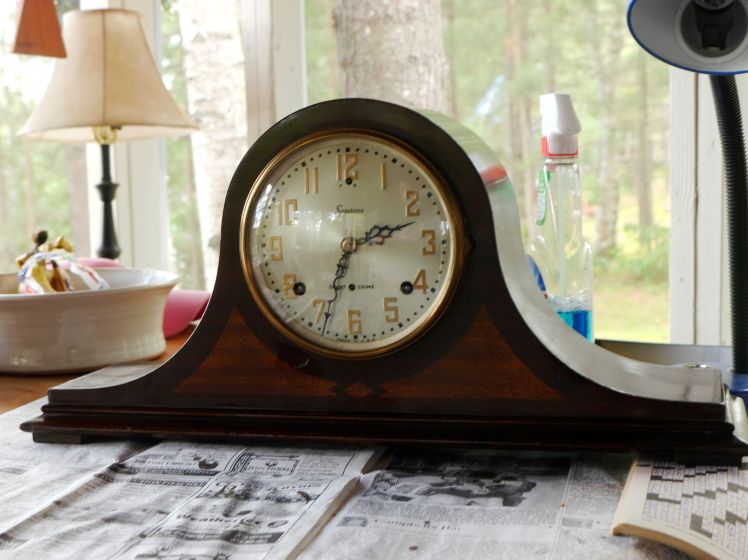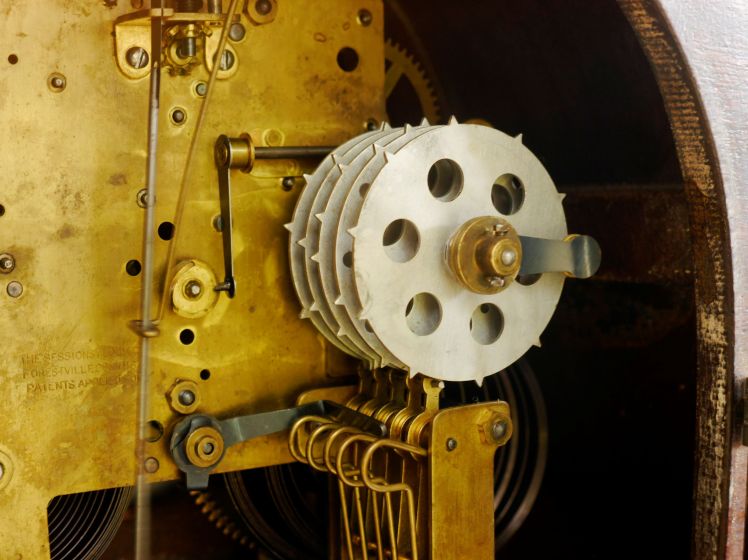This article describes my latest mantel clock find, an American tambour style time, strike and chime clock that has some very interesting features.

It is a Sessions Westminster A mantel clock made in Forestville Conn. The first year of production for this model was 1927. Between 1903 and 1933 Sessions produced 52 models of mechanical clocks, ranging from Advertisers, large and small clocks with logos of various businesses, to wall, or regulator clocks, and shelf or mantel clocks, designed for the home. Some of the Sessions clocks from this period are prized by collectors.

This case is 21 inches long and 10 inches high, has a mahogany finish with a faux wood inlay and raised metal gold-coloured numerals. It has an 8-day Westminster quarter-hour chime movement. The strike and the chime are on the same train. This clock has 2 gear trains to perform what is usually done with three gear trains in most clocks. Rare but not unique.
Although made in the 1920’s, Sessions had to compete with every other American clock company as chime clocks became very popular. Movements with 3 gear trains were the norm; three arbours, one for each train. Sessions chose a radical approach, and designed the two-train Westminster movement with only two mainsprings. Economies of scale meant that the dial fit other time & strike mantel clocks as well.

This particular clock was sold in 1931, an inscription testifies to the date. The sale price in 1931 was $29.95, a working man’s salary in the 1930’s. This is a $20 flea market find.
The time side runs well but the chime and strike side is not working. It has either a broken or a disconnected mainspring or perhaps some other major issue is lurking within.
This clock has a reputation for being difficult to work on. Some horologists will not touch it because of its quirkiness and the amount of time it takes to repair but I plan to give it a shot, not now but once I gain moire experience in clock repair.

Thanks for posting this information about the Sessions clock, I was informed that I am going to get one as a house warming present. I haven’t received it yet but know that it is going to need to be cleaned and repaired. Nice to have some background info to give the clocksmith (when I find one!)
Karen
LikeLike
Thanks for your reply Karen. It is a stunning clock and will be a centre piece in your home. Unfortunately mine requires extensive repair so I have put it on the back burner until my skills sets improve. You will notice that it has two winding arbors where most Westminster chime clocks have three. The strike and chime are on the same arbor and because of this they are a challenge for an amateur like myself to repair. However, in the right hands they can be successfully repaired.
LikeLike
I finally found a clocksmith (and the funds to pay him) who was able to clean and repair the Sessions Westminster A Mantel Clock I was given almost 5 years ago. It had just been a pretty piece sitting above my fireplace and now it keeps time, chimes every quarter-hour and strikes the hours correctly. I am so pleased that it’s working, reminds me of staying with my grandmother as she had a Westminster clock in her living room. I hope that you were able to work out the hour strike sequence in yours. Here’s a short video of my clock at the hour
https://photos.app.goo.gl/dwNjDyGHc1rSXEnU6
And thanks again for posting this info, there is not much information about this clock to be found and I’m glad you took the time to share!
Take care,
Karen
LikeLike
Thanks for your comment. I am sure that your clock repair person had their work cut out for them as this is not an easy clock to service. I spent a lot of time correcting the strike side on mine and like yours, mine runs very well. It is a clock I will always keep in my collection.
LikeLike
Hello your WP theme doesnt seem to show up under the browser DEMONECROMANCY 89 I suspect its a problem coming from WP or your WP theme https://blackmetalbands.wordpress.com/2016/03/25/the-difference-between-halloween-and-valentines-day/
LikeLike
Hi, Usually I consider this type of response to be spam but if there is something specific you are referring to you, I would like to know. Otherwise if I don’t see a reply it is, as I suspected, another piece of spam.
Ron
LikeLike
Quite informative, look forwards to visiting again
LikeLike
Thanks for dropping by.
LikeLike
Hi – I have the same clock – I was looking for the approx. age. Thanks for sharing. BTW, the clock is not inlaid – it is a mahogany case, where they masked off portions when they stained, to give a 2-tone appearance. Take a close look, and you will see the mahogany grain is continuous across the case, whereas if there were inlays, you would see different grain in the inlay portions.
LikeLike
Thanks for your reply. Yes, I am now aware of the “inlay” cheat which I gather was done to save costs. I recently replaced the click on the chime / strike side but cannot calibrate the strike sequence which means that I will have to tear it down to look for wear in both trains. Otherwise it appears to be a great clock and I look forward to spending a little more time on it.
Ron
LikeLike
I enjoy reading your site. Thanks for your time! http://tinyurl.com/j7a425c
LikeLike
Thanks for coming to my blog and I am glad you enjoyed the articles.
LikeLike
Hey Ron! I recently came into possession of an electric Sessions Westminster chime clock (No. 27). Any suggestions for where/how to date it? I don’t see any jeweler’s marks.
I’ve never tried to work on an electric clock before. I’m an engineer so I know electrical basics, and I’m going to start with replacing the cord. Any other suggestions?
Thanks,
Margaret
LikeLike
I am familiar with the 26 which was made in 1932 which had two synchronous motors, one to work the time and the other to work the strike and chimes. The 27 must be similar and made a year or two later. I have the earlier mechanical version as you know but what I have heard is that you have to be cautious from a safety point of view as the electric versions do appear to run on a full 120 volts, and are non grounded. Both motors get quite warm when running and this is normal. They require 3-5 watts to run so most of the energy produced is heat. If they don’t get warm, they are broken. Sessions date their clocks by their labels on the inside door panel. If the label was intact it would give you the month and year of manufacture. Hope this helps.
LikeLike
Thanks, that helps a lot. I took the motors off and took the mechanism out of the case and the motors definitely have to go. There’s some caustic looking ooze on one, and the other… well the rotor that it was powering has a pinion on it that moves the clock. That’s not a setup I’m comfortable with, especially because I don’t know what metals were used for the rotor and pinion, which appear to be one piece.
I’m looking up alternatives to perhaps replace these with. You’d think two 120 V 60 Hz AC synchronous motors wouldn’t be so hard to find, but the trick is that exact 60 Hz. That’s EXACTLY one revolution a second and (no pendulum) thats what kept the time in the clock. I see plenty that are “50/60 Hz” which obviously is not nearly exact enough. I will keep looking though! Worst case scenario maybe I can convert it to mechanical…
LikeLike
If you find a mechanical movement it will fit but it better be in great shape because they are a devil to fix basically because they have only two trains, one for the time and the other for strike and chime when normally clocks have three winding arbours to perform those tasks. Most clock repair folks don’t like working on them. You will also have to drill two holes in the dial to accommodate the arbours.If you find exact replacement motors on EBay for example you will be paying upwards of $50 each for them, if you can find them. Good hunting!
LikeLiked by 1 person
Thanks Ron! My first attempt will be to find 60 Hz motors at a low voltage and rig them to a battery pack. I’m curious as to how accurate these clocks were in the 1930s relying on 60Hz exactly from the power company.
LikeLike
I am looking for the value of a Kienzle Square Westminster mantel clock cir.1910 made for the Roeblings. I find images, none are exactly the same? Very close, but the links lead me nowhere?
LikeLike
Hi, Thanks for coming to my blog. When you say “square” are you referring to the shape of the clock or the clock face or both? Can you provide me with a photo? You can send it to ronjoiner@gmail.com.
LikeLike